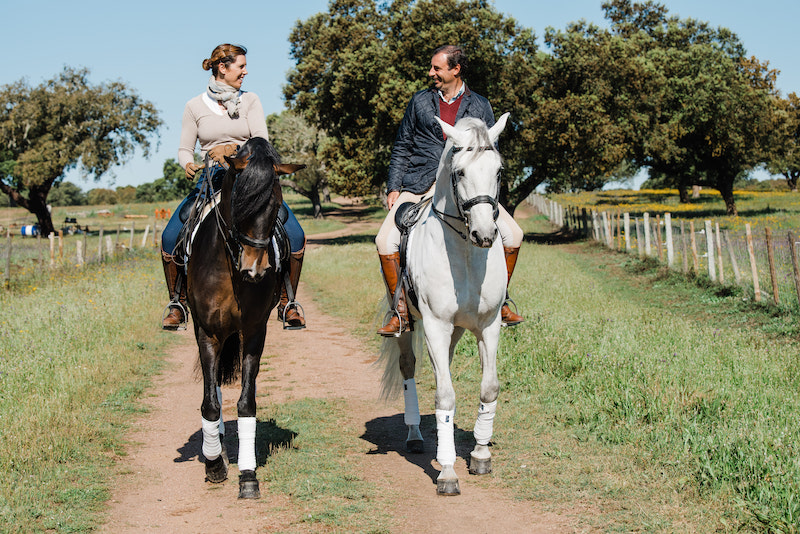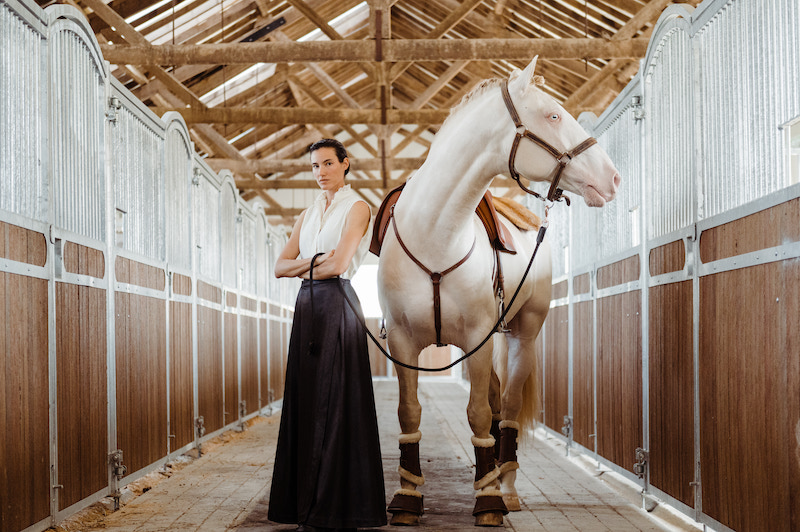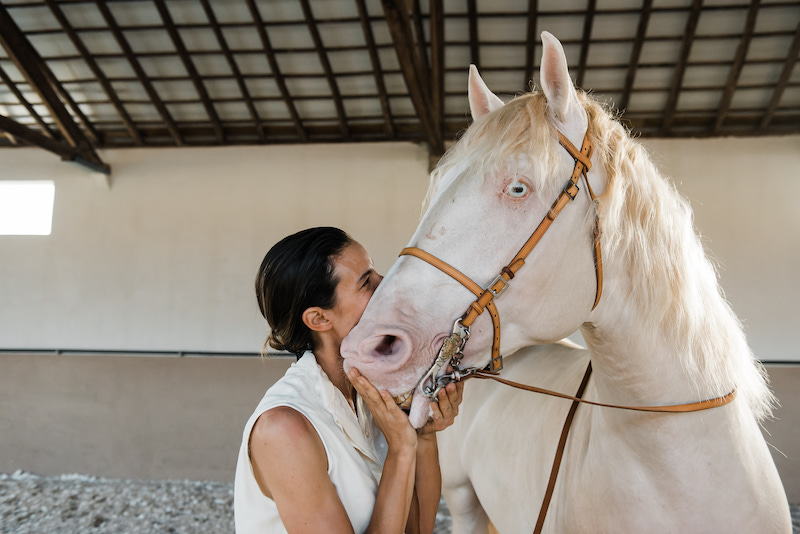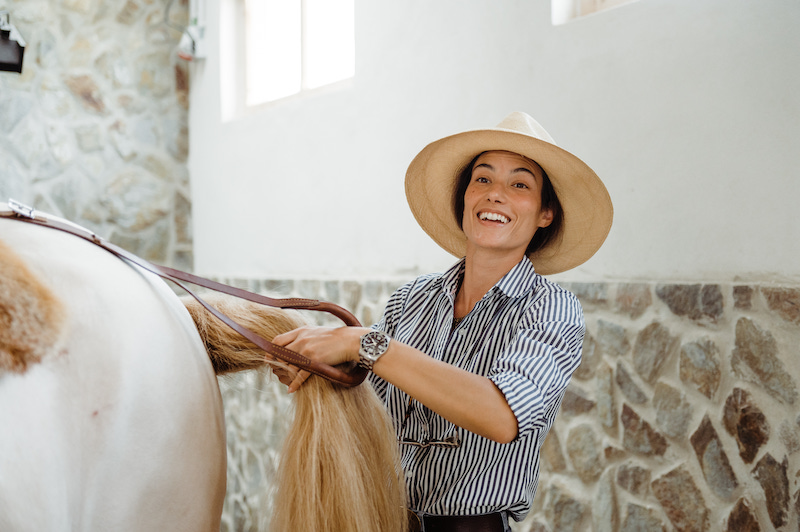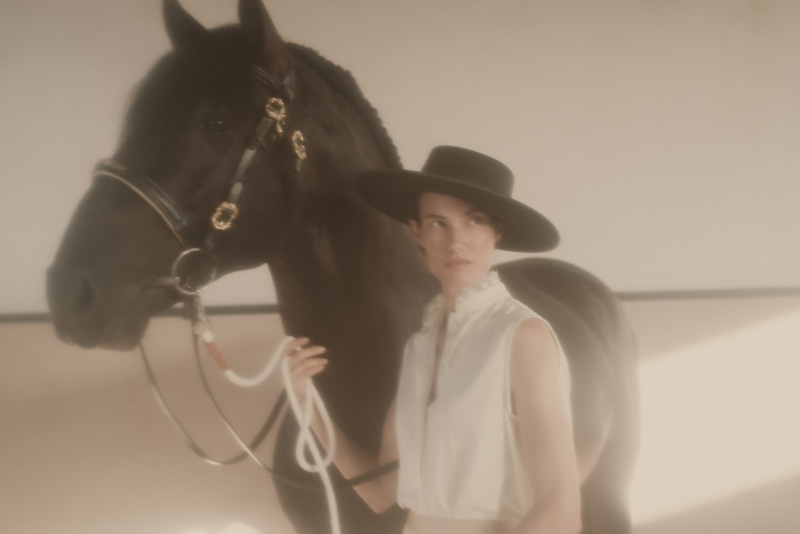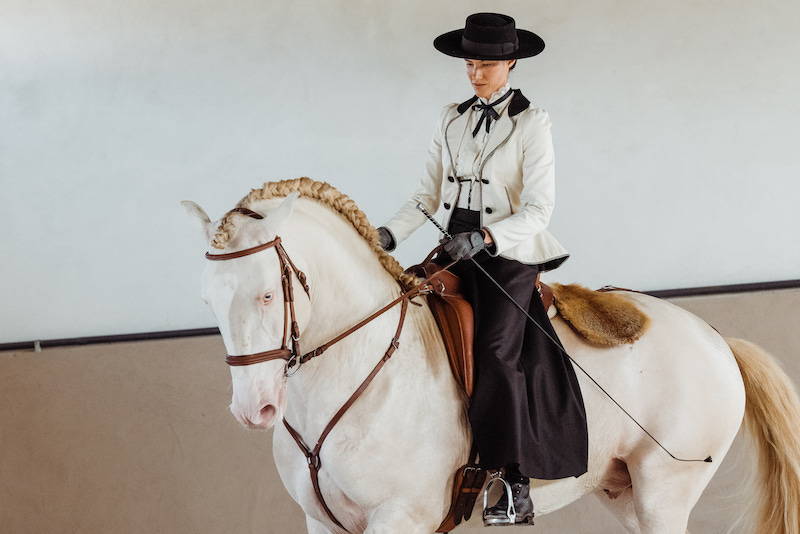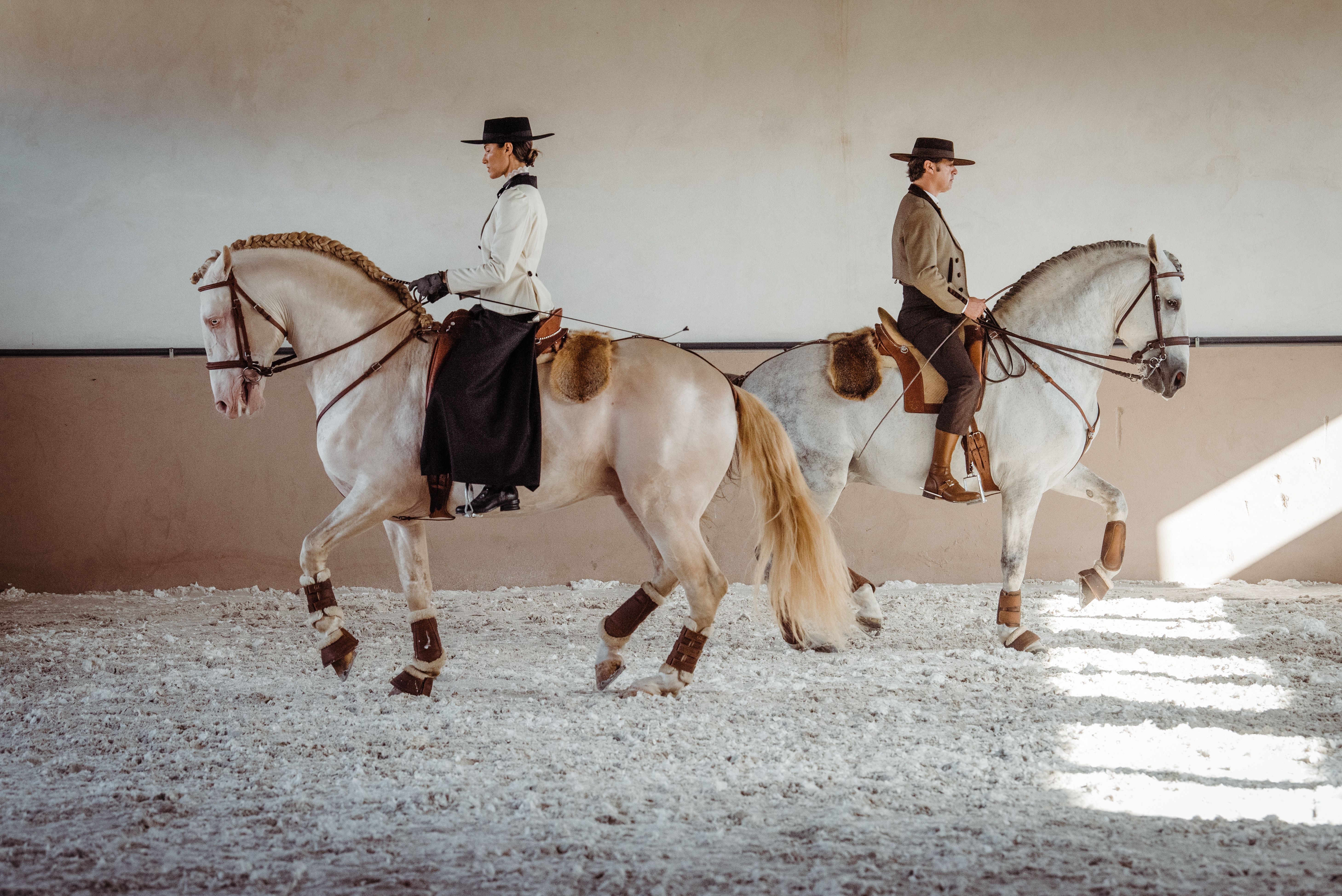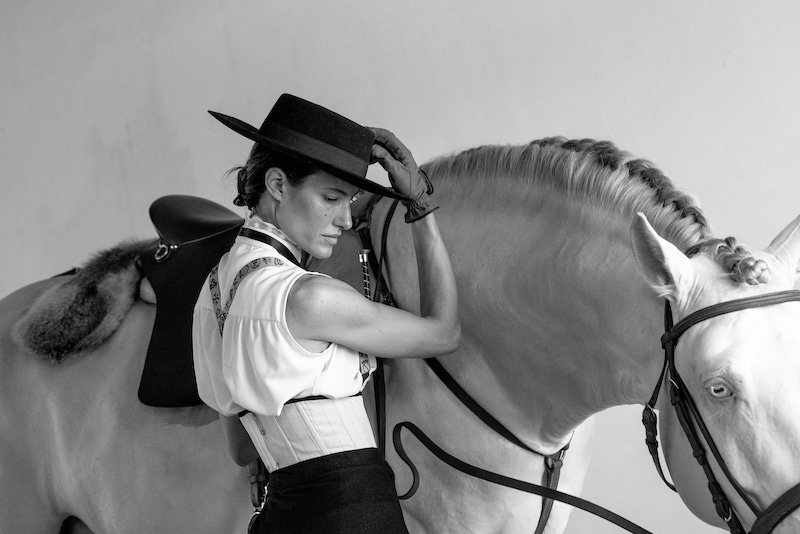The Art of Balance
THE ART OF BALANCE
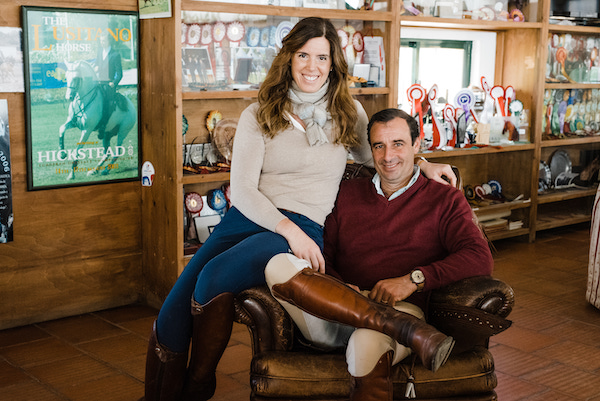
Text Therese Alhaug Photo Lena Saugen. Made in collaboration with Teresa Burton.
If you watched Rodrigo’s Olympic debut, you might remember how he played his way down the final line holding one hand on the reins. His big smile made it look easy and fun, making us curious to know more about this playfully yet technically solid duo. A chat that led us into The Art of Balance.
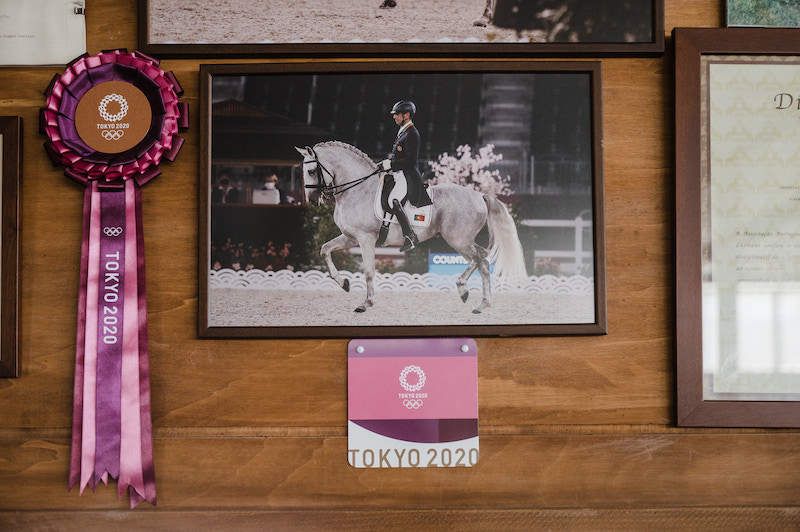
EQUILIFE and LUSITANO HERITAGE visited the Olympic debutant at his family farm in Alentejo, Portugal, where Rodrigo began his riding career working the farm cattle and competing in working equitation. A different background than most dressage riders. He early performed at equestrian events, including his favourite performance: riding without reins.
“In Tokyo, just before entering the freestyle, I told Rodrigo to have fun in the ring and reminded him that he was fortunate to have four reins to hold this time!” Rodrigo’s wife, Maria Amaral, says, laughing.
Maria has significantly influenced Rodrigo’s dressage career, being a successful Grand Prix rider herself. The two equally guide each other in the dressage arena.
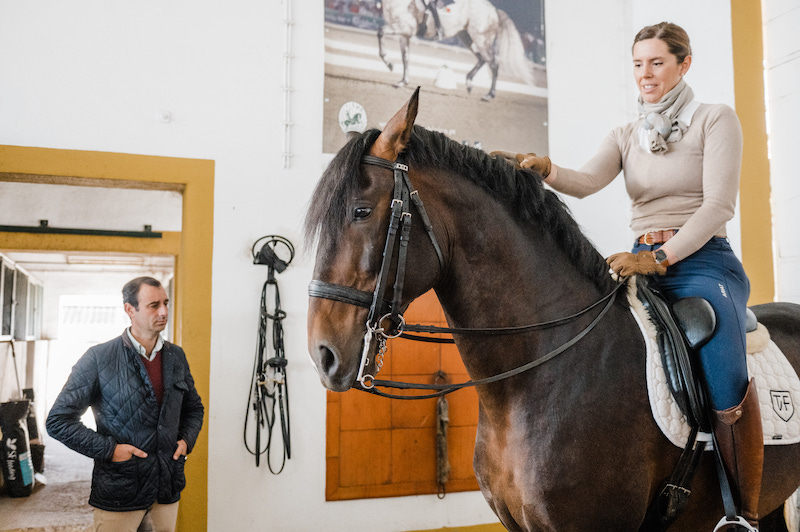
“Each horse has its natural balance, some more to the front and others more to the hind legs. This is something they are born with. So when you start training the horses, you have to look for this.”
Rodrigo Moura Torres
THE ART OF BALANCE
Rodrigo’s family has bred horses for a long time. They also produced Rodrigo’s Olympic partner, Fogoso.
“I know Fogoso inside out, which helped me a lot when we entered the arena in Tokyo,” Rodrigo says.
One of Rodrigo’s early masters, Mestre Joao Lopes Aleixo, taught him the importance of the seat to have balance and control and to give impulsion from behind; Create harmony with invisible aids. Still today, Rodrigo is working on this.
“When riding 2-3 km outside, moving the horse and the cattle, it requires the horses to be comfortable with me. They need to be straight, in the same rhythm, and very well balanced,” Rodrigo explains. “This is something I have tried to surge since the beginning of my career as a dressage rider.
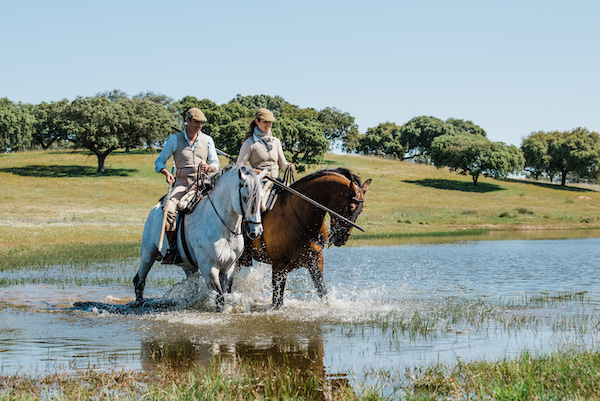
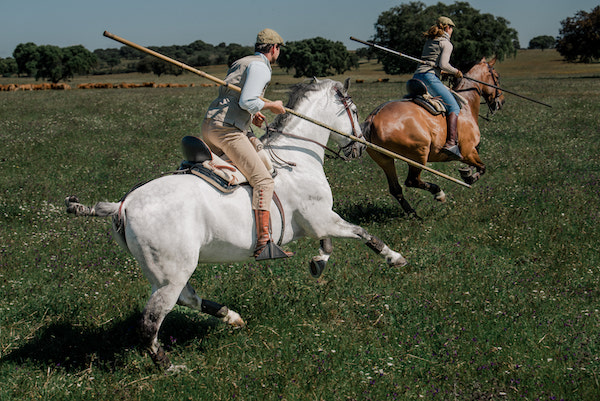
“When riding 2-3 km outside, moving the horse and the cattle, it requires the horses to be comfortable with me. They need to be straight, in the same rhythm, and very well balanced,” Rodrigo explains. “This is something I have tried to surge since the beginning of my career as a dressage rider.”
Rodrigo Moura Torres
Living in the middle of the countryside, Rodrigo’s father and grandfather used horses to move cattle, giving the horses the genetics to deal with pressure. The first horses were bred for bullfighting and then working equitation, but in the last ten years, they turned their eye to producing dressage horses. Rodrigo still uses his knowledge from the fields when working the youngsters.
“As a breeder, I work the horses since they are young. First, I must find the ideal balance for the horse in all gaits and exercises. I pay notice of this in the lunge already. Each horse has its natural balance, some more to the front and others more to the hind legs. This is something they are born with. So when you start training the horses, you have to look for this,” Rodrigo says, pointing out that each horse is different and has its different rhythm.
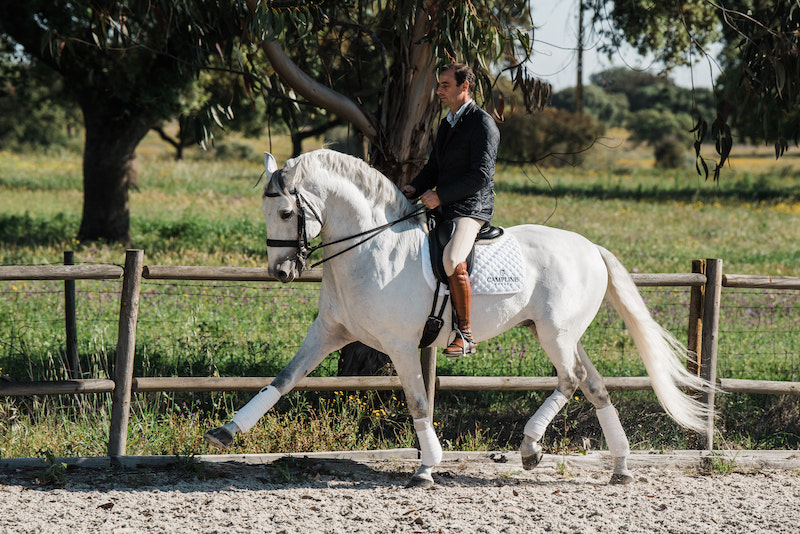
“Since Fogoso was four, he could already do everything. I could play with some piaffe and some passage. It was very easy for him because he was very well-balanced. He was already giving me everything, and I just took advantage of these natural things he gave me.”
Rodrigo Moura Torres
FINDING THE NATURAL BALANCE
We visit the farm on a crisp morning in spring. The horses are grassing in the sunrise on large fields dotted with colourful wildflowers and cork oak trees. A scenery that the family takes advantage of when riding out, allowing the horses to stretch and gallop alongside with the cows and horses in the fields.
Rodrigo’s dad, Carlos, has already started grooming the Olympic hero Fogoso, who’s now 12yo, for Rodrigo to ride.
The powerful stallion demonstrates the dressage evolution in the Torres family’s breeding strategy: a horse that loves competitions and rises to challenges confidently.
“At competitions, Fogoso truly shines. He loves being in the spotlight,” Rodrigo explains.
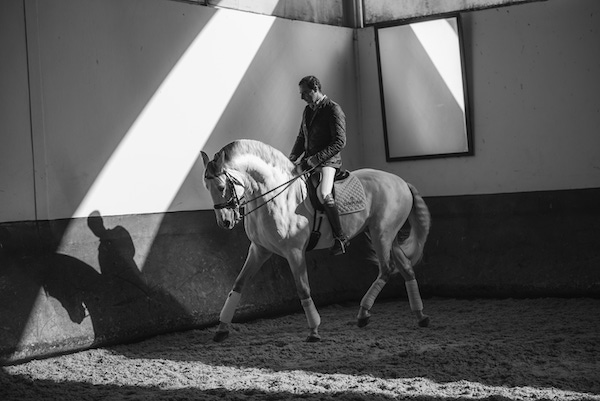
“Since Fogoso was four, he could already do everything. I could play with some piaffe and some passage. It was very easy for him because he was very well-balanced. He was already giving me everything, and I just took advantage of these natural things he gave me.”
The Lusitano breed is known for their natural talent for passage and piaffe due to their short and powerful physic. Something Rodrigo has in mind when training them.
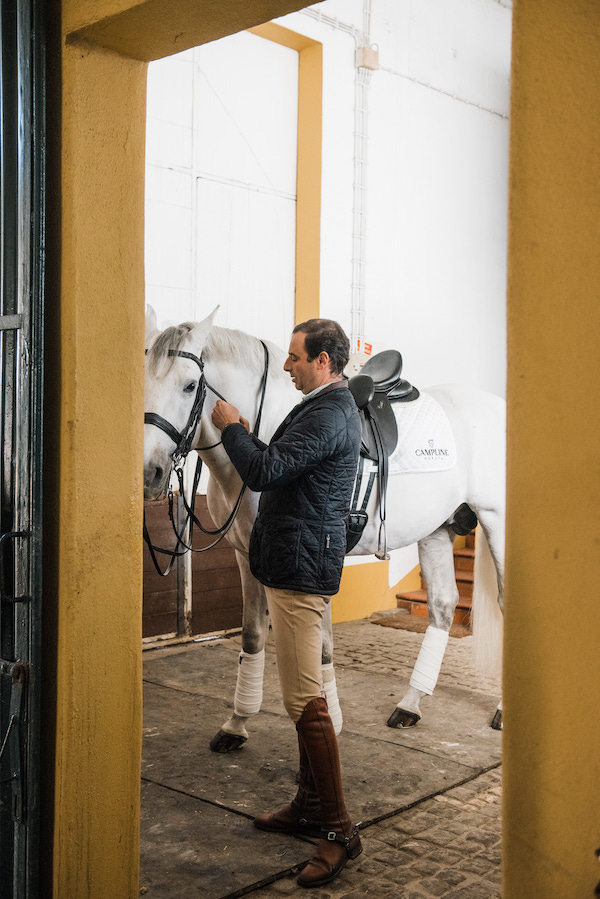
“When a horse is balanced & strong, and accepting my aids, I can ask nothing, and he will do everything.”
Talking about the breed, how do you implement the German training scale?
“The training scale is logical. I always try to go through the training scale, but when riding, you must feel what you must do at every moment. Sometimes you have to go back a little, then maybe two or three steps forward, then back again etc. Riding is not mechanical. You see; It’s the horses saying to me what I need to do. Not me.”
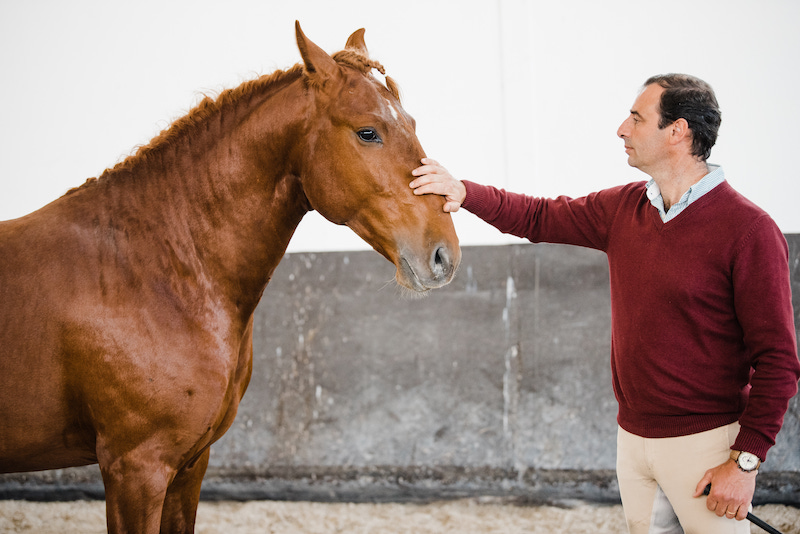
Rodrigo explains how Lusitanos naturally can be presented earlier to collected exercises.
“Some Lusitanos are already, as a 5-year-old ready for 3-4 steps in piaffe, because it is natural for them. I do this just for the horse to ‘feel it’. I never push them. I rather try to understand exactly what to do at every moment. This is my philosophy. Step by step, I give them more and more tasks, and step by step, they give me more and more in return.”
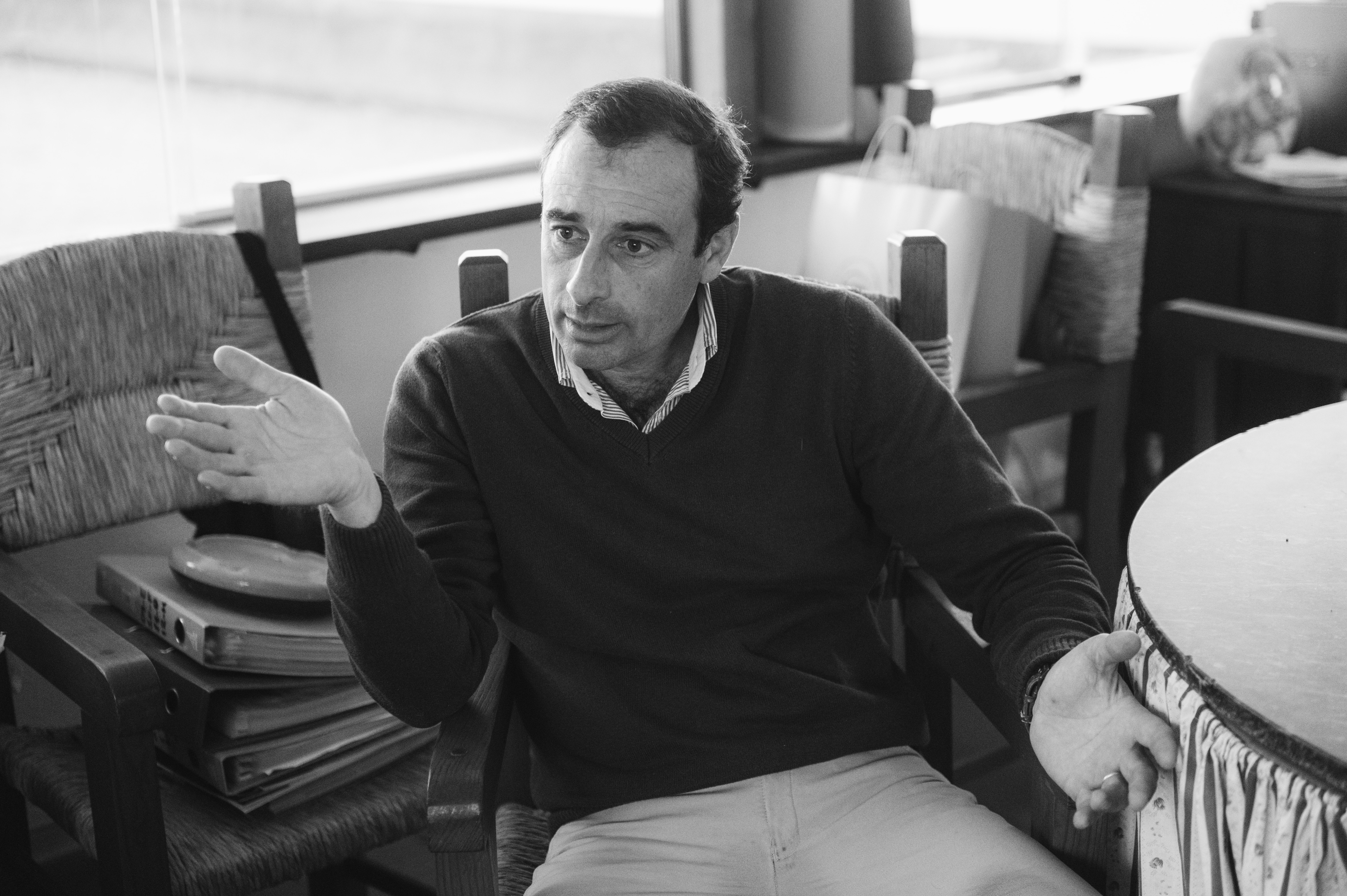
“When a horse is balanced & strong, and accepting my aids, I can ask nothing, and he will do everything.”
Rodrigo Moura Torres
Rodrigo puts his head up to demonstrate:
“If you see horses move naturally in freedom, they do so many difficult things. And they always keep their head up. So why should I sit on them and put their head down, destroying their natural balance? To make a horse improve, you need to keep him healthy. And for this, we need to understand the difference between the breeds.”
“We cannot go to full extension with a Lusitano when they are young, as this might ruin them. While a Lusitano might play with piaffe as a 5yo, my warmblood started passage when he was 8. So we must keep attention to their natural balance and ask what they have to offer.”
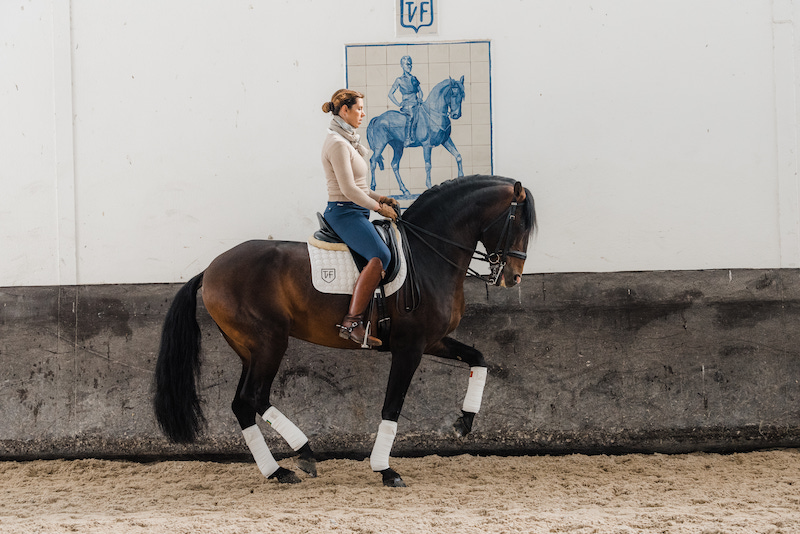
“The rider’s balance will be good if the horse can move in a good balance. You can sit still, and your legs don’t have to push. The horse will move through his back and into your hand.”
Rodrigo Moura Torres
He continues:
“Some Lusitanos can ruin their body if they go big before they are strong and on a higher level. To go forward is one thing but to push is another thing. You simply cannot force something they cannot deliver to you. Approximately 95% of the dressage horses today are warmbloods, so the training scale which is good itself – is based mainly on warmbloods. We need to keep that in mind and foster what they are good at. The things they are not so good at will come naturally when they become stronger
and more confident.”
Talking about balance, how would you describe a rider in balance?
“Many trainers say if the horse goes wrong, the rider is not sitting in a good way. I don’t believe this. The rider’s balance will be good if the horse can move in a good balance. You can sit still, and your legs don’t have to push. The horse will move through his back and into your hand.”
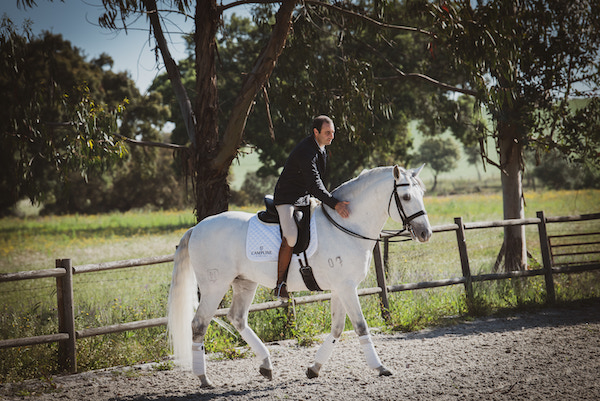
Maria adds:
“You might notice how Rodrigo is moving a bit up or forward when going into halt or piaffe. One of the judges in Tokyo even commented on this, that he fell a bit forward in the exercise, but it’s actually natural for him. He feels it will help the horse, and that in that moment it will loosens his back and support the balance.”
Rodrigo:
“If I keep the natural balance of the horse and the horse work in harmony, the midpoint is the rider, so I try to keep the center of his balance to where I am sitting. If I sit behind this center, the weight comes too much to the hind legs. The rider needs to be in self-carriage, as I don’t want to destroy the balance of the horse. As an example, the gravity of the pirouette should be where I am sitting.”
“If I keep the natural balance of the horse and the horse work in harmony, the midpoint is the rider, so I try to keep the center of his balance to where I am sitting.”
Rodrigo Moura Torres
Despite their achievements in the ring, the duo is not seen often at bigger shows. Rodrigo explains.
“My main goal is to keep Fogoso healthy and happy so we prefer shows close to home, as we don’t want to push him with travelling. Even as a youngster, we opted to only start competing when he turned 7 years old, and we only do 2-3 bigger competitions a year. The remaining time we keep him in his routine at home doing his normal horse life.”
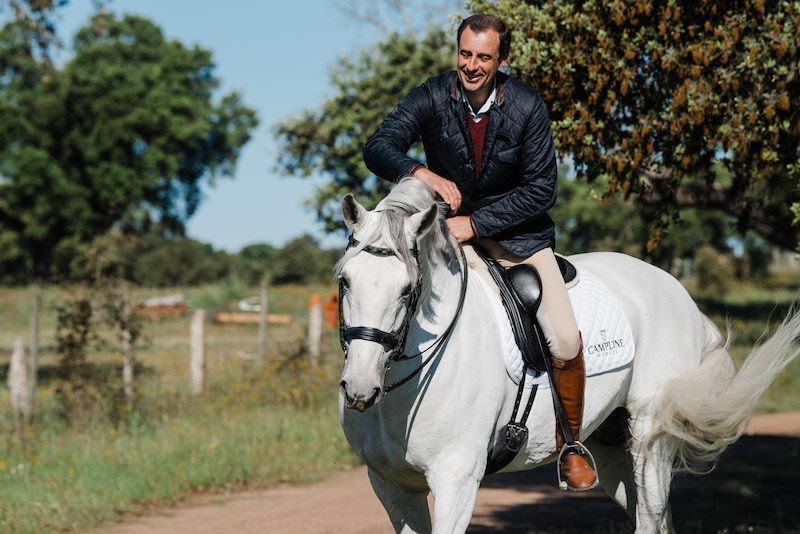
“The way I see it, show jumping is much more about business, which requires more travelling, while dressage, for many, is not so much about that. It’s more about making a name for yourself and delivering unique performances at the right stages. So we dont want to travel to the other side of the world if we dont have to.”
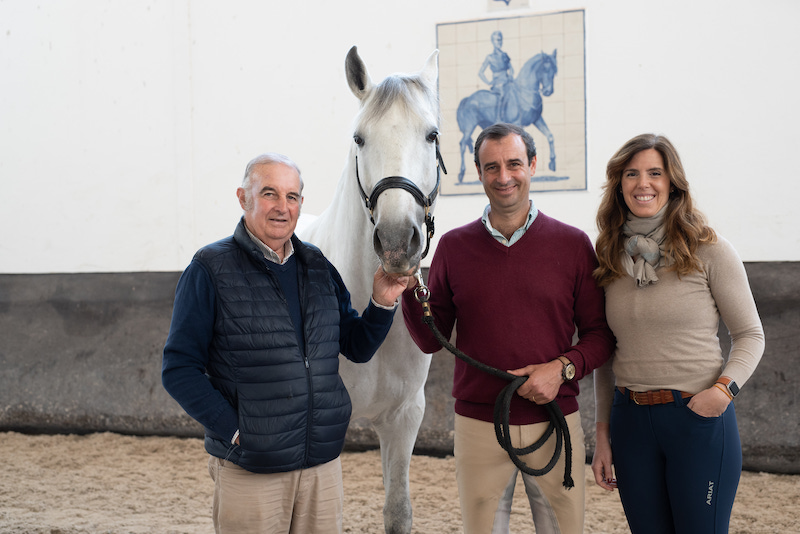
We want to thank the Torres family for having us over and Lusitano Horsefinder for collaboration with us to make this trip possible.
